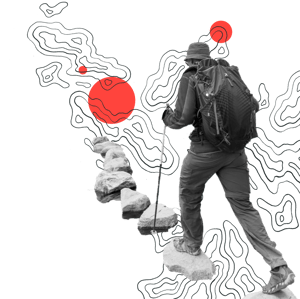As a leader, there are always multiple topics or themes that demand your attention, each seeming to be the most important of the moment. With so many options and opportunities, how can you choose where to focus your time and energy? How do you apply each topic not only to your own skill development, but the development of your team? By taking a focused approach, selecting a handful of leadership topics, and integrating them into your skill development, you can slowly build the leadership abilities of yourself and your team.
Top 5 Leadership Topics
We took input from peers and business leaders, clients and participants in the Expedition and Endurance programs to get a sense of what the most relevant leadership topics are in their respective fields, and compiled this list of the top five leadership topics right now. For each topic, we also provided questions you can ask yourself and how you can apply Exploratory Leadership to the topic, so you can integrate each into your life and workplace.
1. Employee Wellbeing
There’s no denying that COVID-19 has changed nearly, if not every, aspect of life, including professional life. Faced with a pandemic, many people have reevaluated their priorities, and are placing a stronger emphasis on their personal lives and wellbeing. With that comes an increased emphasis on employee wellbeing. In order to win over and retain high-quality employees, leaders must prioritize employee wellbeing in new ways.
Ask Yourself: How are you supporting employees’ health, mentally and physically? What policies or procedures can you change to better support employee wellbeing? How can you build a culture that prioritizes and rewards employee wellbeing?
Exploratory Leadership Practice: Part of maintaining wellbeing is having a connection to one’s sense of purpose. Leading your team through a Purpose Practice will help them reconnect to their “why” to provide energy and resilience even for challenging or draining situations.
2. Adapting to Hybrid Work
 Many workplaces are embracing hybrid or remote work. With new work styles, though, come new challenges — employees report feeling frustrated with communication, more out-of-touch, and less creative in remote scenarios than they did in person, among other challenges. As a leader, your role is to ease the transition and make working remotely or in a hybrid scenario as seamless as possible.
Many workplaces are embracing hybrid or remote work. With new work styles, though, come new challenges — employees report feeling frustrated with communication, more out-of-touch, and less creative in remote scenarios than they did in person, among other challenges. As a leader, your role is to ease the transition and make working remotely or in a hybrid scenario as seamless as possible.
Ask Yourself: What are your hybrid or remote work policies? What tools would make asynchronous work go more smoothly? How can you support relationship-building without being in person?
Exploratory Leadership Practice: Collaborate with peers on what has and has not been working well for them. Having a Learning Community that you can lean on in times of change or uncertainty will help you find new possibilities, ideas, stress test your ideas, and be supported by your community. Within your teams, adopting and leveraging the practice of Learning Communities will foster connection, develop trust, and nurture a learning culture while bridging the gap between in-person and at-home team members.
3. Navigating the Unknown
The world continues to change rapidly, and with those changes come more uncertainties. While you can’t plan for uncertainty, you can develop clarity around how you will deal with it. For example, reframe your perspective on risk, and embrace finding new opportunities, the only certainty is that the world will continue to have unknowns. Accepting that and learning to adeptly navigate between the known and unknown will prepare you to find new possibilities, be more comfortable with the unknown, and be more flexible in moments of need.
Ask Yourself: How do I feel about the unknown? What are my current “knowns”? What are my current “unknowns”? How can I practice moving between the two? How can I practice being more comfortable in the unknown? How can my organization embrace the unknown?
Exploratory Leadership Practice: Your mindset will be key. Find three words that generate energy, excitement, and motivation in you (e.g., curiosity, generosity and growth). Those are indicative of your Curious Explorer’s Mindset. That characterization of your mindset can help as you approach problems and find new solutions to the challenges you face. As you face a challenge, ask yourself how you can grow from it and explore the possibility it provides with curiosity.
4. Practicing Empathy
No one is perfect; there are bound to be moments when you and your employees slip up or miss the mark. In those moments, practicing empathy can be a vital differentiator for you as a leader. In fact, many employees believe empathy is one of the most important traits a leader can have. Modeling and encouraging empathy in the workplace can lead to more connection, more engagement, and better work performance.
Ask Yourself: When have I demonstrated empathy recently? When could I have been more empathetic? What is one small action I can take every day to build my empathy? How can I encourage my team to be empathetic?
Exploratory Leadership Practice: Create an Empathy Map to help you understand your team’s feelings and needs. Consider what their feelings may be now, or “before” you act, and what you’d like them to be in the future, or “after” you act. What are the necessary steps to take to move from “before” to “after”?
5. Professional Development (Self + Others) 
Having the opportunity to grow one’s skills is vital to remaining an active participant in today’s world. As a leader, you should aim not only to continuously learn new skills and polish your existing ones, but also empower those around you to do the same. Giving your team the opportunity to invest in what they’re excited about will go a long way to ensuring they remain active participants in the workplace, and will help them contribute in new ways to the betterment of the team as a whole. Approach development through the lens of possibility, rather than utilizing mandated, check-the-box training. Ask yourself questions like, What’s possible if you and your team develop new skills and behaviors? And what are the consequences if you and your team don’t?
Ask Yourself: What skills do I have that I think are rusty? What are my (or others’) skill gaps or blindspots? What topics interest me that I would be excited to learn more about? What is the sweet spot between my existing responsibilities and my interests? How can I encourage my team to take time for professional development? What resources can I offer them?
Exploratory Leadership Practice: Our book, “Explore or Expire,” offers a condensed overview of the principles of Exploratory Leadership alongside practice exercises, so you and your team can begin to uncover new possibilities as part of your professional development journeys. For example, ask yourself, “Where does my purpose overlap with the organization's vision, mission and purpose and what can I do with my unique ability to add value in the face of the unknown?”
Using Leadership Topics to Upskill Employees
For many leaders, challenges arise in understanding how best to support their team members and employees through their skill development processes. As with understanding leadership topics, there are so many differing opinions and perspectives on the “right” way to upskill employees. We’ve provided one set of ways you can incorporate these skills into your workplace, but there are many other ways to upskill employees. Play around and find the combination of these approaches that works best for you.
One of the ways leaders can apply leadership topics to employee skill development is by focusing on employee wellbeing. Allowing employees to choose their own skill development paths on their own timeline helps them feel connected to the topics, motivated to learn, and driven to apply the skills. Providing reasonable boundaries for employees to learn and grow also keeps them engaged. Offering a variety of learning experiences, such as lunch and learns or online training, can also help them build connections, even in a hybrid work environment.
In general, navigating the unknown encourages employees to go out of their comfort zones. In the process of navigating the unknown, employees can uncover new possibilities — and potentially new skills. Either way, they will be flexing new muscles and trying new things, which can lead to growth. Be empathetic with them, and encourage them to be empathetic with one another and themselves throughout this growth process. Practicing empathy consistently can help employees learn it in a natural and applicable way.
Finally, give employees opportunities to practice skills and receive feedback in safe environments. Research shows that the best way to learn new skills is to practice them in a low-stakes environment, such as among peers. Incorporating opportunities to apply new skills into professional development increases the likelihood that those skills will be internalized and used in the workplace.
Overall, we’re here to say the “right” way is the way that helps your employees learn best, apply their skills, and feel courageous in navigating the unknown — whatever that looks like for them.
Exploratory Leadership as a Foundational Leadership Topic
Of the leadership topics above, each can be applied in unique ways to your specific situation, field, and role to improve your skills and leadership style. However, for each leadership topic, the principles of Exploratory Leadership can be applied to help you explore the unknown with clarity, confidence, and motivation. Unlock your full leadership potential with Exploratory Leadership — learn more on our website, and contact us for information on how you can bring Exploratory Leadership to your teams.



SUBMIT YOUR COMMENT